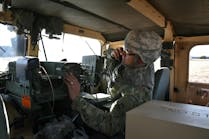New power system cuts voltage fluctuation in V-22
By John McHale
CEDEX, France - A new power-management system that engineers from Kollmorgen Artus of Avrille Cedex, France, developed for the U.S. Marine Corps Bell Boeing V-22 Osprey tiltrotor reduces voltage fluctuations from generators, eliminates occasional power interruptions, and increases fuel savings over the life of the aircraft.
Kollmorgen experts developed a new converter for the power-management system that has two stages: input transfer in the first stage, and a buck module that uses switching technology on the second stage, says Adam Tardry, manager of power generation and conversion at Kollmorgen Artus.
The new system virtually eliminates the voltage fluctuations that are characteristic of current aircraft designs, he says.
Each converter in the system uses a non-interruptible power system at high speed, says Franck Bubey, Kollmorgen`s sales and marketing director.
Previous generations of this equipment could not control power and would not react quickly when transferring high voltage. The new system uses voltage-sensing power within an electronic switch, which is much faster than any mechanism in other systems, Tardry says.
Currently, aircraft designers must use large wires and include special systems to compensate for voltage fluctuations of more than 10 volts. By using the Kollmorgen converter, voltage fluctuations hold within a range of 0.1 volts. This means designers can use small, light wiring and eliminate separate power-conditioning equipment.
"Efficiency today is all about getting peak performance from every component of your design," says Gideon Argov, CEO of Kollmorgen Corp. "This is what our unique power management system has done for the V-22. Ultimately, this technology will help provide safer, less expensive air travel for consumers."
"The power management system lessens the range of voltage fluctuation by 99 percent and provides uninterruptable power," explains Robert Perrin, managing director of Kollmorgen Artus. "This allows the wiring to transmit power in aircraft to be much lighter, since it will not need to be oversized to deal with wide power fluctuations.
"This development will save weight, help lower costs, increase fuel savings, and reduce aircraft power-up time before take-off," he continues. "It has the added benefit of providing a flow of uninterruptable power which currently may be occasionally interrupted during flight."
The V-22, manufactured by the Boeing Defense and Space Group Helicopters Division and Bell Helicopter Textron, takes off and lands like a helicopter. Once airborne, its engines swivel forward and convert the aircraft to a turboprop. It can carry 24 combat soldiers, or an internal payload as heavy as 20,000 pounds at twice the speed of a helicopter.
The V-22 Osprey is using the Kollmorgen AC-DC regulated power management system to convert the 115 volt/400 Hz AC power from the aircraft`s generators into regulated 28 volt DC power.
The Bell Boeing V-22 Osprey tiltrotor aircraft, pictured above, will have a new power management system from Kollmorgen that will eliminate power interruptions and increase fuel savings.


